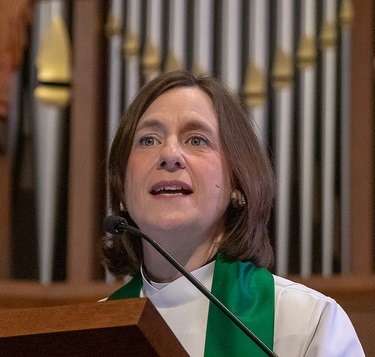
Palm Sunday, April 2, 2023
Penelope Bridges
The year was 1980, I think. The planned installation of American nuclear weapons on British soil generated a national uproar. CND – the Campaign for Nuclear Disarmament – was riding the wave, and a protest march took place in London. I remember participating in that march, the biggest crowd I had ever been a part of. I remember walking past the American Embassy for the first time. I remember the exhilarating feeling of being part of something really big, something that could change the world for the better. Looking at the decades since, I’m not sure that our protests had any real impact; but I still remember the feeling.
On a spring morning in ancient Israel, a crowd gathered around a rabbi as he walked with his friends through the Jerusalem suburbs towards the city proper. Word was, he might be the Messiah they had been waiting for, an avenging champion who would lead the oppressed people of Israel in revolt against the hated Roman occupiers. As the crowd grew and word of his coming flew ahead of them, people started coming out of their homes and covering the road with leafy branches, even creating a red carpet of sorts from their cloaks and blankets. Jerusalem was packed for Passovertide with pilgrims and tourists from all over the Jewish world: the crowd swelled quickly to massive proportions as people joined the parade, catching the mood of hope and celebration from their neighbors.
One version of the story says they pulled palm fronds off the trees and laid them in front of the leader: palm fronds, a symbol of victory and courage, almost equivalent to our use of medals, offered in anticipation of the change he was expected to bring to the holy city. He came to the crest of a hill, the Mount of Olives, with its expansive view and a precipitous path down into the city, and he paused while his friends scouted the neighborhood for a way to make his entrance as impactful as possible.
You could say that this was Jesus’s greatest moment. He had the attention of the whole city. He was hailed as a hero. He was making an entrance that deliberately reminded people of the ancient kings of Israel. As he crested the hill at the Mount of Olives, he was riding the crest of a popular wave. And he rode it all the way to the Temple: the way Matthew tells it, Jesus went directly to the Temple and overturned the money changers’ tables, before offering healing to all who approached him. And with both of these actions he created the circumstances that would lead inevitably to his death.
There is a deep irony built into this story of the Triumphal Entry of Jesus, and it takes several forms.
First, the adulation of the crowd, their apparent recognition of God’s sovereignty manifested in Jesus, can also be seen as the latest iteration of the devil’s temptations to worldly power. Just as Jesus had looked down on the world from on high when he encountered Satan in the desert, so now he looked down from the Mount of Olives on the center of the Jewish world; he must have known that in that moment he had the power to lead an attack on the Roman garrison, to light a fuse that would ignite a revolt, to claim the ancient throne. But, bookending our Lenten lectionary, he will once again refuse to put the Lord our God to the test.
Another irony: this crowd was, frankly, delusional. They completely misunderstood the nature of Jesus’ mission. They looked for a military leader, someone who would play into the violence of the time and start a war, someone who would use the world’s power to take control of their world. But they couldn’t have been more wrong.
Yet another irony: this same crowd, cheering the Messiah today, would a few days later bay for his blood. Most of them probably didn’t recognize the condemned man carrying the cross on Friday as the same one who had led the parade on Sunday. They were fickle: ready to shift at a moment’s notice from euphoric celebration to a lynching. Their loyalty to Jesus was not even skin deep.
And finally, there’s the irony that this triumphal procession will lead straight into the stronghold of Jesus’ enemies and place him in their power; and they will ensure that the end of his story is as far from triumph as it could get: a rigged trial, an agonizing walk of shame up another hill, this time to Calvary, and a horrific and very public death.
The rhythm of this day is jagged and steep: we join the crowd to follow Jesus on a rollercoaster: down from the Mount of Olives and then up again to Calvary. Our participation in the liturgy swings from the fun of the procession and the palms, to the grim shouts of Crucify Him and the silence of the tomb. It is hard, this journey: it tests us. We are tempted to avert our eyes, to avoid it all, to go directly to Easter without passing through Holy Week.
But we must not. We are to live into all our parts in this story: as cheering pilgrims, as a bloodthirsty mob, as grief-stricken disciples. And after it all we will celebrate the Eucharist, proclaiming the true end of the story: Christ has Died, Christ has Risen, Christ will Come Again. We will share the bread of life and the cup of salvation. We will be reminded that earthly glory is hollow, that death is not the end, that love wins. And we will find the strength to follow Jesus on the Way, the Way of Love, that will ultimately bring us to the joy of Easter Sunday.

